We often consider foraging a springtime activity as we anxiously await the first greens after winter. But autumn is harvest season. Traditionally, this is when we stocked our root cellars with nature’s final bounty to help us last through the winter.
Even though nights are shorter and the air is getting crisper, as you walk through the woods, you will find that the forest abounds with fruits, nuts, and berries.
Roots and tubers are plump and ready to be dug up. Even some of our spring favorites make a brief autumn appearance providing fresh greens.
It’s always best to begin with plants you know and recognize if you are new to foraging. If you are harvesting an unfamiliar plant for the first time, you should consult an expert. Often common poisonous look-alikes are growing.
Rosehips
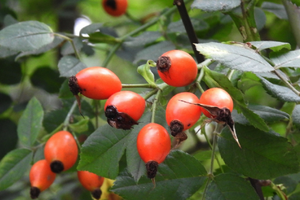 Did you know roses produce fruit? If you leave your roses on the bush, rather than pruning, a small red fruit will grow.
Did you know roses produce fruit? If you leave your roses on the bush, rather than pruning, a small red fruit will grow.
Tart and high in vitamin C, rosehips are delicious jammed or as a tea.
Rosehip tea is a refreshing tonic that can help you fight off winter colds and flu.
⇒ Three Powerful Natural Remedies You Need To Keep On Hand This Autumn
You can find rose hips on unattended rose bushes (or simply don’t prune yours). You just want to make sure you don’t forage from plants that may have been sprayed with harmful pesticides.
Grapes
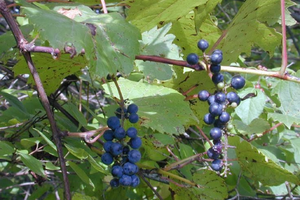 Another common fruit you can find growing is wild grape. Like their domesticated cousin, wild grapes grow in clusters on vines. They are deep purple, tending toward blackish. And they typically fruit from July until October, so keep an eye out for them on your autumn walks.
Another common fruit you can find growing is wild grape. Like their domesticated cousin, wild grapes grow in clusters on vines. They are deep purple, tending toward blackish. And they typically fruit from July until October, so keep an eye out for them on your autumn walks.
Persimmon
While you may think of Persimmons as a Southern fruit, they actually can be found growing as far north as New York and as far west as Texas.
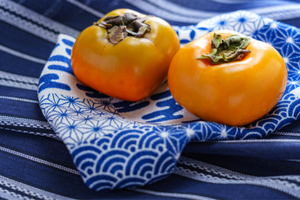
They ripen in mid to late fall, making them perfect for autumn foraging.
You can tell the fruit is ready to harvest because it is soft and detaches easily from the tree.
If your fruit is not quite ripe yet, it will continue to ripen once it’s been picked.
And you do want your persimmons ripe. They are decidedly tart before they ripen and deliciously sweet when ready.
You can eat them raw, use them for jams or desserts, or try your hand at Persimmon wine.
Elderberry
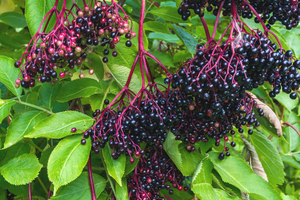 You can forage elderberry in the fall as a staple for your medicinal apothecary.
You can forage elderberry in the fall as a staple for your medicinal apothecary.
The deep purple berries have been used for centuries to treat colds and flu, as well as headaches, coughs, and issues.
Related: How to Use Herbs and Make Your Own Cold Medicines at Home
The berries can be made into jam, syrup, or tea. Just make sure you cook them, as raw berries are poisonous. Consuming raw berries can cause gastrointestinal distress, vomiting, and diarrhea.
Wild Apples
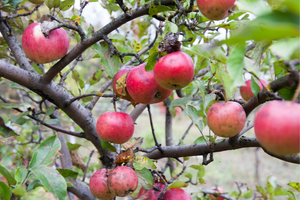 Apples abound in autumn. Many apple trees were planted in the past and give fruit long after the person who planted them is gone. Other apple trees grow wild from seeds casually strewn on a walk or from fallen fruit. Wild apples can be sweet or sour– you never know. All of these apples, including crab apples, can be foraged and eaten.
Apples abound in autumn. Many apple trees were planted in the past and give fruit long after the person who planted them is gone. Other apple trees grow wild from seeds casually strewn on a walk or from fallen fruit. Wild apples can be sweet or sour– you never know. All of these apples, including crab apples, can be foraged and eaten.
You can eat the sweet ones straight from the tree but save the tart and sour ones for baking. Pies are great, but applesauce and apple butter can be canned and eaten all winter long.
Making apple cider vinegar is another excellent use for your not so delicious foraged apples. Apple cider vinegar has many health benefits. It also makes a great base for immune boosting fire cider.
Black Walnut
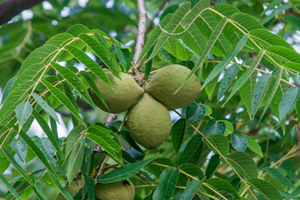 Black Walnuts ripen in September in October, so they are a perfect addition to your autumn foraging list.
Black Walnuts ripen in September in October, so they are a perfect addition to your autumn foraging list.
You can use the outer hulls to make an iodine-rich tincture.
This tincture is anti-viral, antifungal, anti-bacterial, and works as an antiparasitic.
Once you’ve removed the hulls for your tincture, you can try your hand at releasing the delicious nut hidden inside the hard shell. You’ll find it quite a challenge to reach the tasty nut. You can decide for yourself if all the hard work is worth it.
Cattail Roots
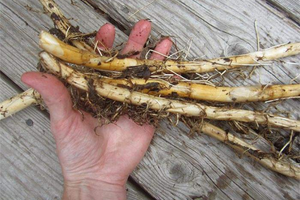 Cattails are easily recognizable by their fuzzy, sausage-like seed pods that give them their name.
Cattails are easily recognizable by their fuzzy, sausage-like seed pods that give them their name.
You can find them near ponds and swamps, as they like water. You should make sure you are always harvesting your cattails from an area that is free of any chemical runoff.
The plants are bio accumulators, which means that they absorb toxic chemicals. This is great if you are looking to clean your water but bad if you want to eat your cattails.
Related: Delicious Recipes Using Cattails – “The Supermarket of the Swamp”
While you can forage cattails year round, we look for their roots (technically a rhizome) in the fall. You’ll find they are larger in the fall than at other times of the year.
Roots can be roasted and eaten or dried and pounded into flour. You can use cattail flour to make pancakes and other baked goods or as a thickener for soups, stews, and sauces.
Cranberries
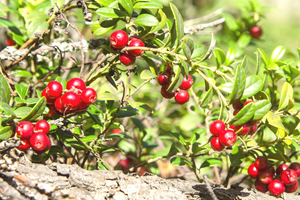 Cranberries are an iconic fall food that I personally feel are underappreciated.
Cranberries are an iconic fall food that I personally feel are underappreciated.
You can add these tart berries to muffins, juices, or, of course, made into cranberry sauce for your Thanksgiving dinner.
Not only do these berries taste great, but they are also medicinal as well.
Cranberries, especially cranberry juice, are often used to help with urinary tract infections. Studies have shown that the compounds in cranberries can help prevent UTIs.
They grow wild in the North Eastern US and Canada. Look for them near lakes, bogs, and swamps. They are ready to harvest in September and October. Keep your eye out for the deep red berries growing close to the ground.
Acorns
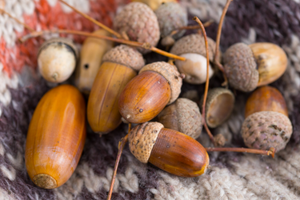 While we may think of acorns as squirrel food, we can eat them too. Unfortunately, we need to do a bit more work with the acorns before we can eat them. Without processing, acorns are high in tannins which can be toxic to humans.
While we may think of acorns as squirrel food, we can eat them too. Unfortunately, we need to do a bit more work with the acorns before we can eat them. Without processing, acorns are high in tannins which can be toxic to humans.
Related: How to Use Acorns as Survival Food
To make your acorn harvest safe for consumption, you will want to boil the acorn meat and then rinse them. You may have to do this several times before you leech out all the tannins. When the acorn meat no longer tastes bitter, you can grind it into a flour and use it for baking.
Sassafras
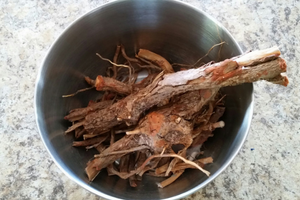 Sassafras was one of the first wild plants I learned to identify as a kid. I learned to identify the plant by its distinctive fragrant leaves.
Sassafras was one of the first wild plants I learned to identify as a kid. I learned to identify the plant by its distinctive fragrant leaves.
While the leaves disappear as fall progresses, you can still harvest the roots in autumn. These roots are what was traditionally used to brew root beer.
I say traditionally because, in the 1960s, the FDA prohibited the use of Sassafras. A scientific study found that large amounts of safrole, a compound found in the plant, potentially caused liver damage in rats.
Since then, people have called into question the study’s validity, and many foragers still use sassafras for tea, to treat ailments like diarrhea, colds, skin diseases. You, of course, will want to make your own judgment on the safety of this plant.
There are many plants that are out there that you can forage in the fall. This list just scratches the surface of the available bounty growing wild in our forests. While foraging can be very satisfying, always ensure you are extremely confident in your harvest before eating anything from the wild.
Always make sure you are foraging from areas that are free from dangerous pesticides and herbicides. Often municipal areas are sprayed to keep down “the weeds.”
You also need to make sure you are familiar with any potentially dangerous look-alikes. Foraging unfamiliar plants can be deadly.
As long as you use common sense and ensure you know the plants you are harvesting, you can easily supplement your diet with food found growing wild year-round.

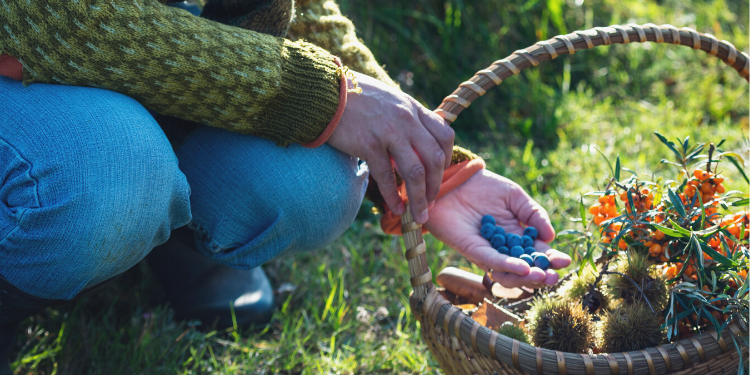













You can NOT compare humans to rats or mice or any animal!!!!!!!!!!!! They do that too scare people into buying their dangerous drugs!!!!!! And for them to make sooooooooooo much money when we could use herbs! Years ago they used natural herbs then found out about using chemicals instead, which they could sell for exorbitant amount of money that is how they can control what is bought! Science is their opinions nothing else!!!!!! Especially in to days realm!
In 1920, in the United States, the life expectancy for men was around 53.6 years, for women, it was 54.6 years. In 2020, in the United States, the life expectancy for men is around 76.3 years, for women, it is 81.4 years.
The reason for increased life expectancy is modern medicine. I use herbal remedies when I find ones that work, but God gave us the ability to harness nature in the form of modern medicine.
Hygiene, clean drinking water etc, not modern medicine
you must be vaccinated
Doug: One great-grandfather never saw a doctor and died at age 97. He ate meat and animal fats 3 meals a day. As time progresses, we’re finding that eating carbs, something people in the city depended on, is the killer. Country people who eat traditional foods rarely have health issues till into their 70s. City people are now into country with many raising as much of their own food as possible including small livestock.
Those numbers are based on bad math because they use an average, and 100 years ago or more, your chances of dying in childhood were astronomical compared to now. (50/50) An infected cut or a cavity could kill. you.
No, that is not true. Living conditions, diet, hygiene, have been the greatest influence on longevity.
Pharma doses simply create side effects that demand more Pharma solutions. Lot of jerks in favor of the death jab here, and maybe you too. Stupid.
Penicillin is about the only thing that deserves huge credit. Basically Pharma creates drugs to treat obesity diseases….heart and diabetes.
Ahhhh but in days gone by they were dead by 40. Common sense all things in moderation.
With the exception of sassafras and cattails, most of the foraged goods presented here or discussion are available here in my city neighborhood. I watch them growing all season long on my way walking to the local supermarket. Only thing is, they are not to be foraged from the garden of a neighbor’s yard unless one is looking for trouble! I don’t look at them so much as medicinal plants, but as tasty treats with which to make some comfort foods, kind of like making chicken noodle soup. For medicine, I will consult with my physician.
In these times…we have become our own doctors as many of the others are betraying us due to brainwashing.
I eat “toxic” dead lab rats with Curry and I am fine! I think the Sake really helps!
I use my nuts to attract in the deer
Be careful you don’t catch a cold doing that.
If the economy crashed completely, 50% of this country would be dead in 6 months…half from starvation, the other half from predation.
The rest of us can live off the land pretty well already and it’s better for you.
Like 3 percent could do that
3% is a made up number. We shall see.
We have five of those on the place along with pears and plums. We are drying apple and pear for pantry storage. rose hip, elderberry, grape, blackberries, and black walnut are all collected on the property seasonally. I try for the hazel nuts, but the Ravens, Steller’s Jays and goats usually beat me to them. Cat tail are close by and horse tail in the spring (kind of reminds me of asparagus for taste). We’re finally getting some rain so hopefully we’ll have a good mushroom season this autumn.
WACK JOB ALERT!!! WACK JOB ALERT!!!
DANGER WILL!!! DANGER!!!
Say what?
People died from accidents, and medical conditions we now have ways to deal with ie, enlarged prostate or other urinary track obstruction, we invented the catheter, bowl obstructions before the days of surgery, breast cancer, etc etc. There are many modern drugs and procedures that are pushed these days.
And many old-time things to use in place of. My doctor thinks I’m cool for it, using things our ancestors did to combat infections and allergies. Had I depended on ‘modern’ meds for a lot of these problems, I’d be dead now. She agrees, and said I must be evil because she started to smoke again. All I said was, tobacco was in every herbalist’s pouch for thousands of years, and that hitler was the one to claim it was the red devil’s weed LOL. niio
Most of this is not attainable in Zone 9A Arizona but what is, is usually ready before midsummer or during the monsoons. We’re collecting the 2nd crop of honey mesquite now, and if winter rains are good (a few inches, no more or we’ll get root rot) then next year we’ll get 3 crops. It’s mid sept and time to plant winter carrots (kyoto from Baker’s Creek), winter radishes (China Rose, daikon, Black Spanish and Black Schifferstadt, see Baker’s creek!) turnips, replant potatoes, kohlrabi and so on. Yeah, and green peas, et al. niio
I just discovered that pawpaws grow near where I live. I made pawpaw bread and put a couple loaves in the freezer! Tastes similar to banana bread.
It’s good to know that Elderberry is poisonous raw as I discovered an Elderberry tree growing on my property this year. I tasted one of the berries. Not good by the way. Good thing it didn’t taste good or I probably would have eaten more and experienced some sort of discomfort.
Good article. Thank you!
Is there any chance some one may have translated your material into Spanish?
This would be life saving for people being displaced from Cuba with no food or medications as their socicty and supplies fail.
Let them fight for Freedom in their own country! We don’t want them here STEALING Our Freedom!
The harvest times are extremely different based on where you live. In southern Virginia for example: elderberries are harvested from late July to early August.
You forgot Queen Anne’s Lace!
.
The roots are the original Carrots, dontchaknow?! And the rest of the plant is edible too.